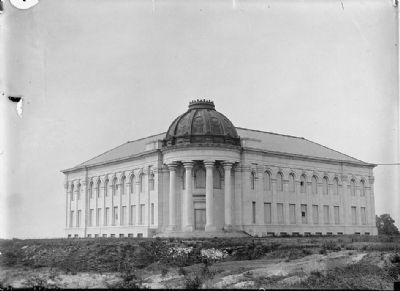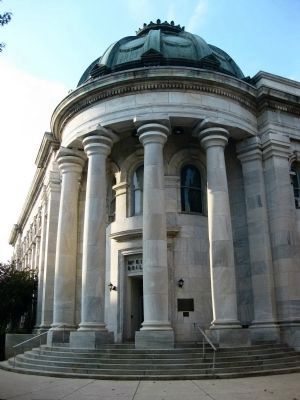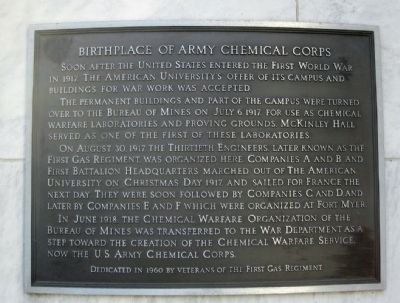Spring Valley in Northwest Washington in Washington, District of Columbia — The American Northeast (Mid-Atlantic)
Birthplace of the Army Chemical Corps
Inscription.
Soon after the United States entered the First World War in 1917, the American University’s offer of its campus and buildings for war work was accepted.
The permanent buildings and part of campus were turned over to the Bureau of Mines on July 6, 1917, for use as chemical warfare laboratories and proving grounds. McKinley Hall served as one of the first of these laboratories.
On August 30, 1917, the Thirtieth Engineers, later known as the first gas regiment, was organized here. Companies A and B and First Battalion Headquarters marched out of the American University on Christmas Day, 1917 and sailed for France the next day. They were soon followed by Companies C and D, and later by Companies E and F which were organized at Fort Myer.
In June 1918, the chemical warfare organization of the Bureau of Mines was transferred to the War Department as a step toward the creation of the chemical warfare service, now the U.S. Army Chemical Corps.
Erected 1960 by Veterans of the First Gas Regiment.
Topics. This historical marker is listed in these topic lists: Education • Science & Medicine • War, World I. A significant historical month for this entry is June 1918.
Location. 38° 56.159′ N, 77° 5.358′ W. Marker is in Northwest Washington in Washington, District of Columbia. It is in Spring Valley. Marker can be reached from Nebraska Avenue Northwest south of New Mexico Avenue Northwest, on the right when traveling south. Touch for map. Marker is at or near this postal address: 4400 Massachusetts Avenue Northwest, Washington DC 20016, United States of America. Touch for directions.
Other nearby markers. At least 8 other markers are within walking distance of this marker. Jeju Jeong-nang (within shouting distance of this marker); Mary Eliza Graydon (about 400 feet away, measured in a direct line); School of International Service (about 400 feet away); Jeju Dolhareubang (about 500 feet away); Korean Cherry Trees (about 500 feet away); Battelle Memorial Building (about 600 feet away); John Fletcher Hurst (about 600 feet away); U.S. Navy Bomb Disposal School (about 600 feet away). Touch for a list and map of all markers in Northwest Washington.
More about this marker. The marker is located on the right side of the entrance to the McKinley Building, on the American University Campus.
Also see . . . The U.S. Army Chemical Corps: Past, Present, and Future. National Museum of the United States Army website entry (Submitted on November 21, 2021, by Larry Gertner of New York, New York.)

Photographed By Harris and Ewing, 1914
2. The McKinley Building on the American University campus
This image, provided courtesy of the Library of Congress, shows the McKinley Building as it appeared in 1914, shortly before the establishment of the Army Chemical Corps.
Click for more information.
Click for more information.

Photographed By Andrew Ruppenstein, September 5, 2009
3. Birthplace of the Army Chemical Corps Marker - Wide View
Here the marker is visible to the right of the entrance to the McKinley Building. The smaller plaque visble below it is in honor of President William McKinley. The cornerstone to the McKinley Building was laid by President Theodore Roosevelt on May 14, 1902, less than a year after McKinley had been assassinated.
Credits. This page was last revised on January 30, 2023. It was originally submitted on August 4, 2010, by Andrew Ruppenstein of Lamorinda, California. This page has been viewed 1,443 times since then and 20 times this year. Photos: 1, 2, 3. submitted on August 4, 2010, by Andrew Ruppenstein of Lamorinda, California. • Craig Swain was the editor who published this page.
